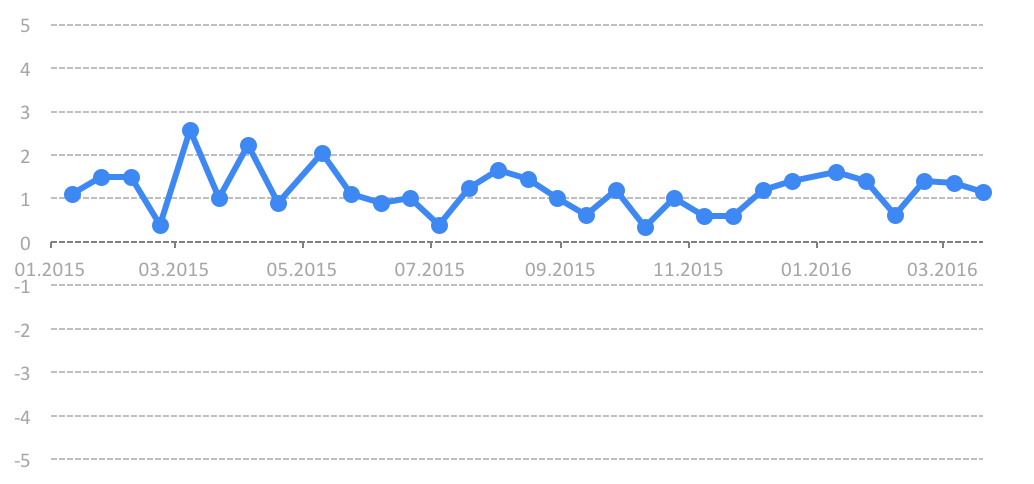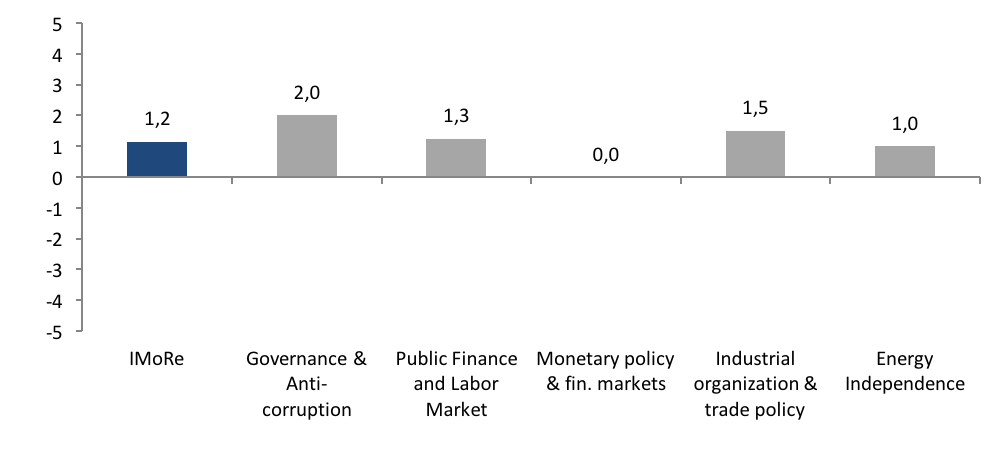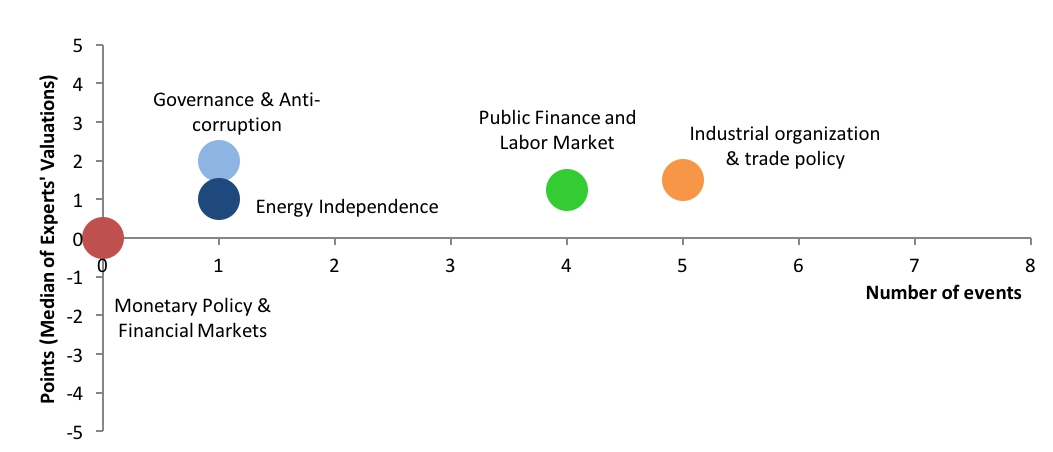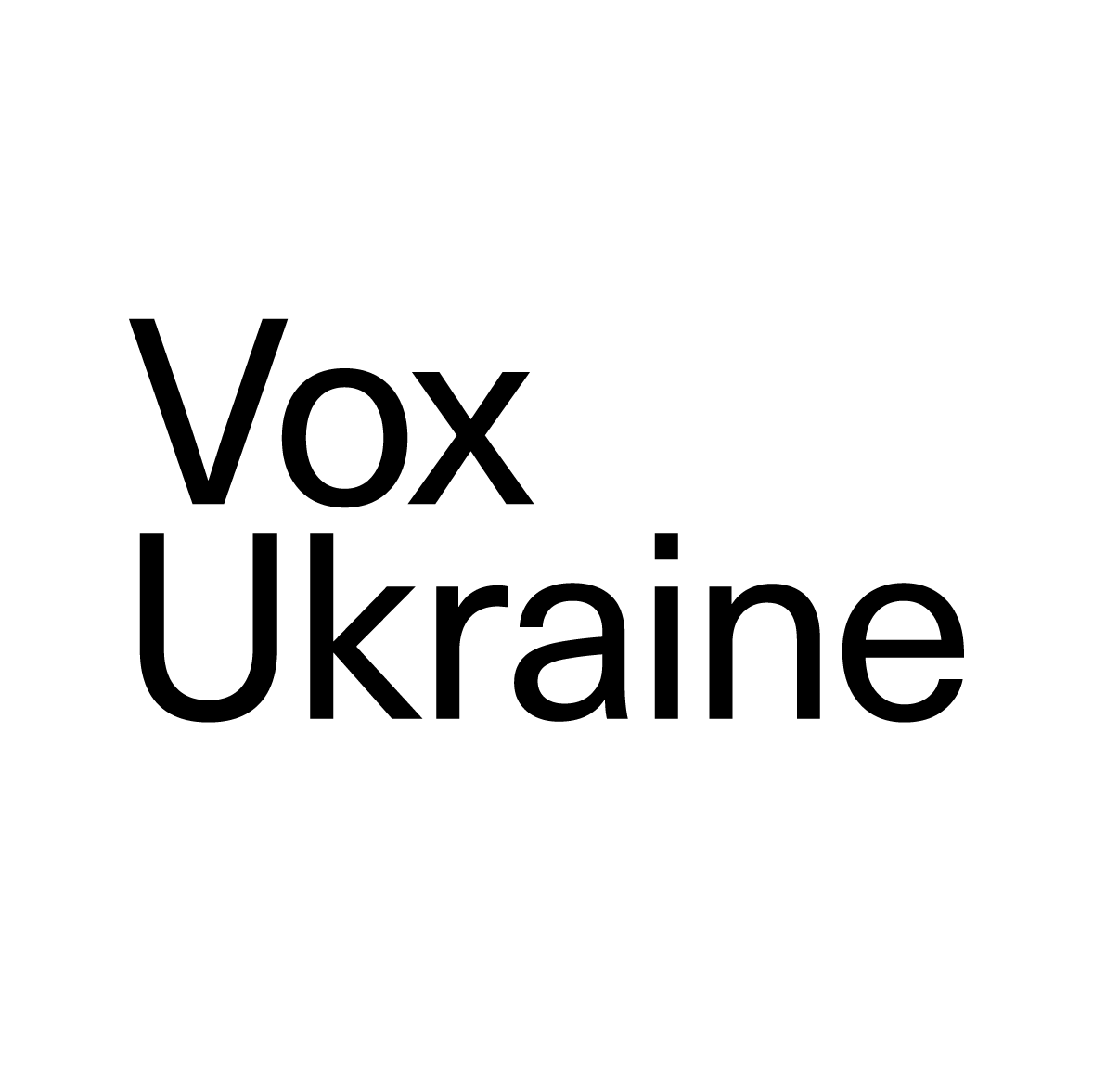Reform Index aims to provide a comprehensive assessment of reform efforts by Ukraine’s authorities. The Index is based on expert assessments of changes in the regulatory environment in five areas.
The current issue included two long-awaited laws – on the improvement of the privatization process and the law on electronic asset declaration of public servants. Nonetheless, despite these positive developments, on March 7-20, Reform Index slid from +1.4 to +1.2 points (possible range from -5.0 to +5.0), since overall pace of reforms remains weak.
Chart 1. Reform Index dynamics.
Reform Index team considers index value of at least 2 an acceptable pace of reform
Chart 2. Reform Index and its components in the current round
The current issue included two long-awaited laws. First, the law on the improvement of the privatization process, which will start the privatization of strategic enterprises and which importance is stressed by experts at every turn. Second, the law on electronic asset declaration of public servants. Until recently it received a lot of criticism and concerns on the part of society and international partners of Ukraine. Nonetheless, despite these positive developments, on March 7-20, Reform Index slid from +1.4 to +1.2 points (possible range from -5.0 to +5.0), since overall pace of reforms remains weak.
The most important positive developments
1) The law to improve the process of privatization +4.3 points
According to experts, the law (1005-VIII of 16.02.2016) will increase transparency of privatization and attract a greater number of bidders, including well-known international companies. The law abolishes the requirement of the mandatory sale of the package of 5-10% of the shares on the stock exchange during the privatization. Given undeveloped stock market and poor protection of shareholders’ rights, this requirement was actually a barrier for international companies to participate in privatization.
This provision was once designed as a mechanism for determining the value of the enterprise. In theory, having sold a small stake in the stock market, the state could use the price of the sold package as the basis for determining the value of the enterprise. In practice, however, there is no stock market at the moment, and under the conditions of a corrupt judicial system, this requirement created corruption risks.
Andriy Boytsun, Centre for Economic Strategy
Apart from that, the law allows engaging of advisors to the sale of state enterprises using not only budget, but also other funds, for instance, resources of international organizations. The law also prohibits participation of legal entities and individuals who are residents of states-aggressors in the sale of public enterprises and introduces the requirement to provide information on the persons in whose interests the acquisition is concluded, including the final beneficiaries.
2) The law on electronic asset declaration of public servants: +3.0 points
The law provides severe, including criminal, responsibility for intentional submission of false information in property declarations of public servants, starting already from 2016.
The law has a double positive effect: first, it is an important anticorruption step, and second, it is a prerequisite for visa liberalization with the EU. Experts point out that according to the latest European Commission report on the implementation by Ukraine of the Action Plan on Visa Liberalisation, the National Agency for the Prevention of Corruption (NAPC) should be fully operational in the first quarter 2016 and launch verification of assets immediately after, which requires the prompt implementation of the law.
3) The new method of calculation of concession fees: + 2.0 points
The new method of calculation of concession fees for the right of companies’ property management (CMU resolution 130 of 4.02.2016) replaces three different methods that existed before. It is based on market formulas, more transparent and consistent with international rules. Consequently, experts expect that it will promote the development of concessions, i.e. contracting out management of enterprises, roads or other assets, primarily public ones, in Ukraine. In addition, the concession fee becomes one of the criteria for determining the winner of the concession tender, which will contribute to more effective selection of concessionaires (managers) of state property and support budget revenues.
4) Ministry of health order regarding reduction of hospital bed capacity to not more than 60 per 10,000 population: +1.3 points
In 2013 the number of hospital beds per 10,000 population was 87.9 in Ukraine, while average EU rate was 52.8. This indicates inefficient use of resources, since instead of beds, resources could have been be allocated for treatment, medical equipment, medical transportation, etc. The Ministry of Health order (51 from 01.02.2016) provides reduction of this rate to 60. However, experts point out the need for integrated approach to reform.
This decision should have been adopted simultaneously with several others… In particular, there is the need to change the approach to day patient facilities, to change treatment protocols (though we have few approved treatment protocols so far). The decision on the autonomy of [medical] institutions also was not adopted and there is a risk that will not be adopted for a long time due to lack of consensus between the Ministry of Health and the Parliament Committee.
Oleksandra Betliy, the Institute for Economic Research and Policy Consulting
Reform Index aims to provide a comprehensive assessment of reform efforts by Ukraine’s authorities. The Index is based on expert assessments of changes in the regulatory environment in five areas:
- Governance and Anti-Corruption
- Public Finance and Labor Market
- Monetary Policy and Financial Markets
- Industrial Organization and Foreign Trade
- Energy Independence
For details please visit reforms.voxukraine.org
Chart 3. Value of Reform Index components and number of events March 7– 20, 2016
Main media partner Project partners

Attention
The authors do not work for, consult to, own shares in or receive funding from any company or organization that would benefit from this article, and have no relevant affiliations




